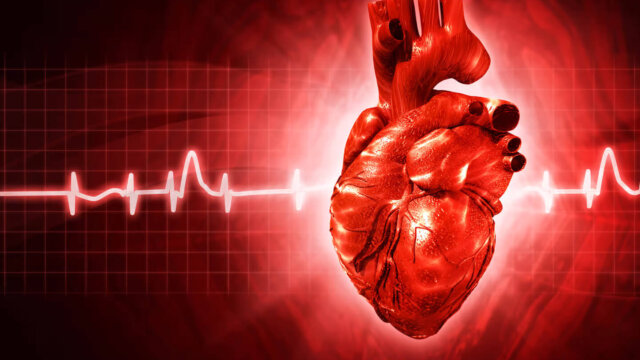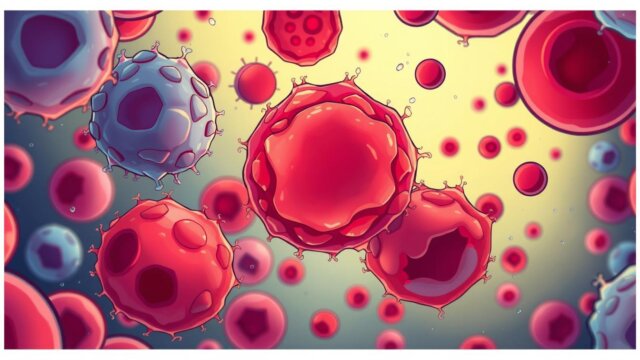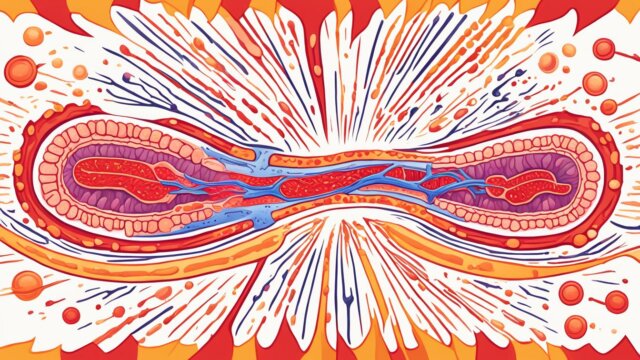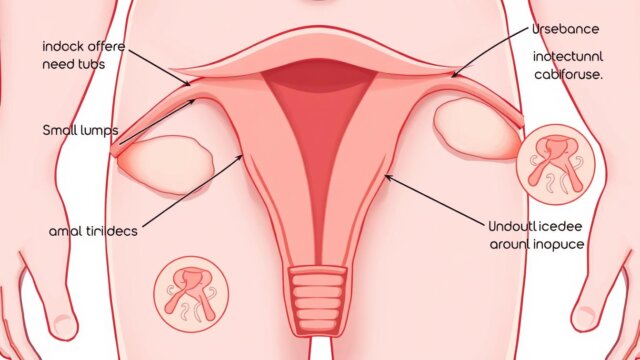FTC disclaimer: This post may contains affiliate links and we will be compensated if you click on a link and make a purchase.
Did you know up to 65% of people worldwide have lactose intolerance? This happens when the body can’t make the enzyme lactase. This enzyme breaks down lactose, a sugar in milk and dairy. So, eating foods with lactose can cause bloating, gas, diarrhea, and stomach pain.
In some groups like Asian, Native American, and Hispanic people, lactose intolerance is more common. It can start at any age, often as people get older. Things like injuries, surgeries, infections, or diseases can also make someone lactose intolerant.
It’s important to know you have lactose intolerance to manage it. Tests like the hydrogen breath test and lactose tolerance test can tell if you can’t absorb lactose well. Knowing about it helps you pick a diet that makes you feel better.
Key Takeaways
- Lactose intolerance is a common issue where the body can’t break down lactose, a sugar in milk and dairy.
- It can cause bloating, gas, diarrhea, and stomach pain a day or two after eating foods with lactose.
- It’s more common in some groups like Asian, Native American, and Hispanic people because of their genes.
- Tests like the hydrogen breath test and lactose tolerance test can show if you can’t absorb lactose and help with treatment.
- Dealing with lactose intolerance often means changing your diet, using enzyme supplements, and eating lactose-free foods.
Understanding Lactose Intolerance
Lactose intolerance is a common issue where the body can’t break down lactose. Lactose is a sugar in milk and dairy. This leads to symptoms like gas, diarrhea, and stomach pain.
What is Lactose Intolerance?
It happens when the small intestine doesn’t make enough lactase enzyme. This enzyme is key for digesting lactose. Without it, lactose moves to the colon. There, it meets gut bacteria, causing bad symptoms.
Prevalence of Lactose Intolerance
About 30-50 million Americans have lactose intolerance. It’s more common in certain groups like Asian Americans and African Americans. In fact, 68 percent of people worldwide can’t fully absorb lactose, especially in East Asia.
It often comes from family and starts in the teen or adult years. Some people are born without lactase, a rare condition called congenital lactase deficiency.
Symptoms can vary but usually show up 30 minutes to 2 hours after eating lactose-containing foods. They include gas, diarrhea, bloating, and stomach pain.
“Lactose intolerance is a common issue that makes it hard for the body to break down lactose, a sugar in milk and dairy.”
Ethnic Group | Prevalence of Lactose Intolerance |
|---|---|
Asian Americans | Higher prevalence |
African Americans | Higher prevalence |
Mexican Americans | Higher prevalence |
Native Americans | Higher prevalence |
Northern Europeans | Lower prevalence |
Symptoms of Lactose Intolerance
Common Signs and Symptoms
Lactose intolerance can cause bloating, diarrhea, gas, nausea, and stomach pain. These issues can start within 30 minutes to 2 hours after eating dairy or lactose-containing foods. How bad and how long symptoms last can depend on how much lactase you have and how much lactose you eat.
Onset and Duration of Symptoms
People with lactose intolerance may feel symptoms quickly. They might get bloating, diarrhea, gas, nausea, and stomach pain a few hours after eating milk or milk products. How long these symptoms last can also vary. Some might feel a bit off, while others could have more serious and long-lasting issues.
The severity of lactose intolerance symptoms can be mild or severe. Some can eat a little dairy without big problems, while others need to avoid it a lot.
“Lactose intolerance is a common condition that can cause digestive discomfort, but it is manageable with the right dietary adjustments.”
Lactose intolerance can really affect your life, but you can manage it with the right food choices. Talking to a healthcare professional can help you deal with lactose intolerance and its symptoms.
Foods That Trigger Lactose Intolerance
If you have lactose intolerance, watch out for foods with lactose. This sugar is in dairy products. It’s also in many other foods and drinks like bread, snacks, and coffee creamers. Always check the ingredient lists to see if lactose is there. Look for words like milk, lactose, and whey.
Stay away from high-lactose foods like milk, cheese, ice cream, and yogurt. Milk has a lot of lactose, especially whole milk. But, cheese like parmesan and Swiss might be okay because most lactose is removed when making cheese.
Other foods to watch out for include cream, milk chocolate, and butter. Butter has a little lactose, but clarified butter has almost none. Some yogurts have good bacteria that help digest lactose.

How bad lactose affects people can vary a lot. Even a little lactose can cause problems for some. Knowing which foods have lactose helps you manage your lactose intolerance and eat well.
Lactose-Containing Foods | Lactose-Free or Low-Lactose Alternatives |
|---|---|
Milk, cheese, ice cream, yogurt, cream | Lactose-free milk, lactose-free cheese, lactose-free ice cream, lactose-free yogurt, non-dairy milk alternatives (almond, soy, oat) |
Baked goods, processed meats, coffee creamers | Baked goods made with lactose-free ingredients, lactose-free deli meats, non-dairy coffee creamers |
Butter, cream-based sauces | Lactose-free butter, non-dairy sauces and gravies |
Causes of Lactose Intolerance
The main reason for lactose intolerance is not having enough lactase enzyme. This enzyme helps break down lactose in the small intestine. There are a few reasons for this lack, like getting older and lactase production going down. Or, it could be from damage to the small intestine from diseases like Crohn’s or celiac. Sometimes, it’s a rare condition you’re born with.
Lactase Deficiency
Lactase is the key enzyme for breaking down lactose, a sugar in milk and dairy. Without enough of this enzyme, the body can’t digest lactose well. This leads to lactose intolerance.
Types of Lactose Intolerance
There are different kinds of lactose intolerance, each with its own cause:
- Primary lactose intolerance: This is the most common type. It happens when lactase levels go down as you get older. It’s more common in people from certain places like Africa, Asia, Hispanic, Mediterranean, and southern Europe.
- Secondary lactose intolerance: This can happen after injuries, illnesses, or surgeries that affect the small intestine.
- Congenital lactose intolerance: A rare type that you’re born with. It’s caused by a genetic issue.
- Developmental lactose intolerance: This affects babies born too early but usually gets better soon after birth.
Lactose intolerance is different from a dairy allergy. It’s more common and not as severe as a dairy allergy, which can be dangerous.
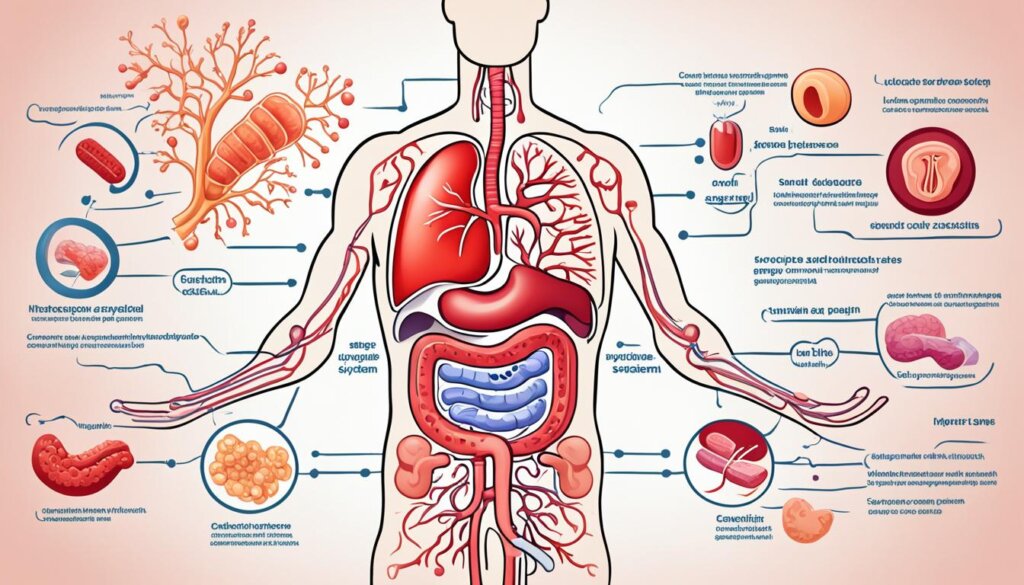
Genetic Factors in Lactose Intolerance
Genetics are key in lactose intolerance. Your background affects your chance of getting this condition. People from Asia, Africa, Hispanic, and Native American groups often have genes that make lactose digestion hard. But, some have genes that keep making lactase into adulthood. This lets them digest lactose well.
Some babies are born with lactose intolerance. It happens when both parents have a certain gene. If both carry this gene, their child might get it too. The chance is 25%.
How well you can digest lactose depends on your genes. Studies show how different groups evolved to handle lactose better or worse. Mixing genes with other groups also played a part in some people’s ability to digest lactose.
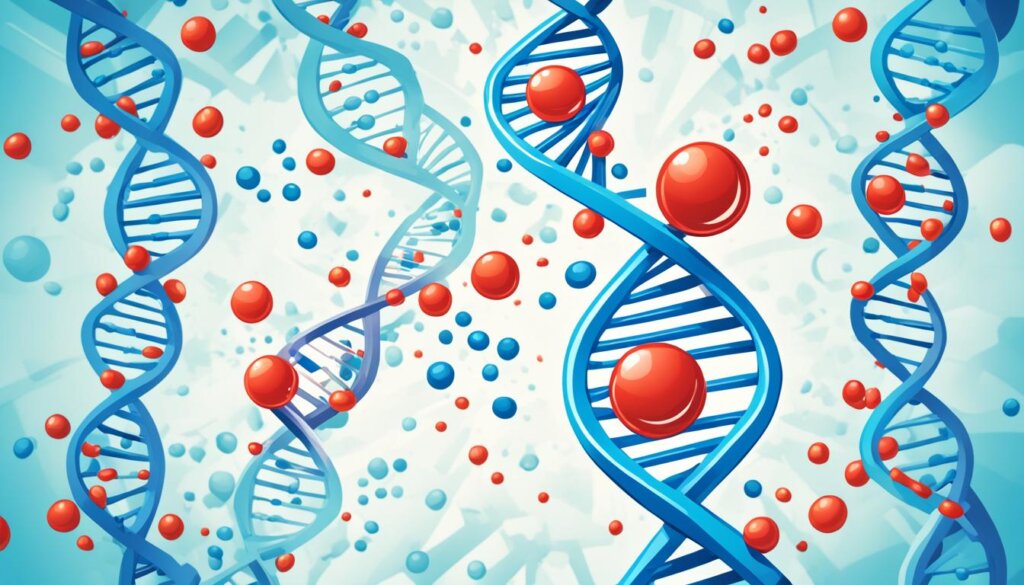
Many things affect how well adults digest lactose. Some genes are more active in some people than others. Studies also link lactose tolerance to how much milk people drink and their health.
Your genes and where you come from can affect lactose intolerance risk. Knowing this can help you make better food choices.
“The worldwide distribution of lactase persistence alleles contributes to variations in lactose intolerance occurrence rates.”
Developing Lactose Intolerance Over Time
Lactose intolerance often starts slowly over time. It’s a common issue that comes with getting older. As people get older, the body makes less lactase enzyme. This makes it harder to digest lactose, a sugar in dairy.
Primary Lactose Intolerance
Most people get lactose intolerance as adults. Symptoms usually start between 20 and 40 years old. It’s often because of genes and a gene change that lowers lactase levels.
Secondary Lactose Intolerance
Secondary lactose intolerance can happen quickly because of intestinal damage or chronic diseases. It can come after an illness, injury, or some digestive issues. Unlike the first kind, this type might go away if the gut heals.
Lactose intolerance can really affect someone’s life. To deal with it, you can change your diet, use enzyme supplements, or eat lactose-free foods. This can help ease the discomfort and keep your gut healthy.

Lactose Intolerance: Symptoms, Causes, Diagnosis and Tests
Lactose intolerance is a common issue that affects many adults worldwide. It happens when the body can’t break down lactose, a sugar in milk and dairy. This leads to symptoms like diarrhea, nausea, bloating, gas, and stomach pain. The main reason is not having enough lactase enzyme to split lactose.
This condition can start at any time and hits some groups more often. About 10% of people in Northern Europe get it, but it’s much higher in Latin and Middle Eastern folks, and almost all in African and Asian groups. It can also come from other health issues like Crohn’s disease or getting older. A rare type is inherited and affects babies whose parents have the gene for it.
Figuring out if someone has lactose intolerance is key to helping them feel better. Tests like the hydrogen breath test and lactose tolerance test can spot the problem. These tests help doctors know how to treat it and what diet changes to suggest.
People with lactose intolerance can eat less lactose by choosing foods with less or no lactose. They might also take lactase supplements and eat foods with calcium to stay healthy. Knowing about the symptoms, causes, and tests helps them live well with lactose intolerance.
Diagnosing Lactose Intolerance
If you think you might be lactose intolerant, your doctor can suggest tests to check it. The main tests used are the hydrogen breath test and the lactose tolerance test.
Hydrogen Breath Test
The hydrogen breath test is a top choice for finding lactose intolerance. It checks the hydrogen in your breath after you drink a lactose drink. If your body can’t digest lactose, it makes more hydrogen, which shows up in your breath.
Lactose Tolerance Test
The lactose tolerance test looks at your blood sugar after you drink a lactose drink. If you don’t have the enzyme to break down lactose, your blood sugar won’t go up like it should. This means you might be lactose intolerant.
Both tests can tell if you can’t absorb lactose well and help tell it apart from other stomach issues. You usually need to not eat for 8 to 12 hours before the test.
If you’re diagnosed with lactose intolerance, you might need to eat fewer foods with lactose, like milk and cheese. Some people can have a little bit of dairy without problems, but others need to avoid it all. You can also take lactase supplements to help digest lactose and ease symptoms.
Remember, lactose intolerance isn’t the same as a milk or dairy allergy. It’s not an immune reaction but rather trouble digesting lactose. Talk to your doctor if you keep having bad symptoms after eating lactose.
Managing Lactose Intolerance
Living with lactose intolerance doesn’t mean you have to give up dairy. You can still enjoy dairy with some changes and the right products. This way, you can get the benefits of dairy without the bad symptoms.
Dietary Modifications
To manage lactose intolerance, cut down or avoid foods with dairy and lactose. Try lactose-free milk, yogurt, and cheese for the same nutrients without the lactose. Plant-based milks like almond, soy, oat, or cashew are great choices too.
Hard cheeses like cheddar and Swiss have little lactose and might be okay. But, soft cheeses, ice cream, and high-lactose dairy should be eaten less.
Enzyme Supplements and Lactose-Free Products
Over-the-counter lactase enzyme supplements can help too. These come in caplet or chewable form and help break down lactose. This lets you eat more dairy. Also, many stores now have lactose-free milk, cheese, and dairy products for easy access.
With these strategies and supplements, most people with lactose intolerance can get enough calcium and vitamin D. They can also avoid bad digestive issues.
“Lactose intolerance is a very manageable condition, and with the right approach, you can enjoy dairy and maintain a balanced, healthy diet.”
Conclusion
Lactose intolerance is a common issue that many people face. Studies show it affects a big part of the world’s population. It’s most common in some areas and groups, like East Asians and Africans.
But there’s good news. Most people can manage lactose intolerance by changing their diet. They can use lactase supplements and eat lactose-free foods. Cutting down on certain foods can also help improve digestion.
There’s even a new DNA test to help diagnose lactose intolerance. This test is an easy way to find out if you have it.
By learning about lactose intolerance, people can eat better and feel better. It might also help with other gut issues. So, it’s key to talk to doctors and eat right to stay healthy.
FAQ
What is lactose intolerance?
Lactose intolerance is when your body can’t break down lactose, a sugar in milk and dairy. This leads to symptoms like bloating, gas, diarrhea, and stomach pain.
What causes lactose intolerance?
It’s mainly because of not having enough lactase enzyme. This enzyme breaks down lactose in your small intestine. Lack of it can come from age, genes, or other digestive issues.
How common is lactose intolerance?
It’s quite common, affecting 30-50 million Americans. It’s more common in groups like Asian, African, Hispanic, and Native American people.
What are the symptoms of lactose intolerance?
Symptoms include diarrhea, nausea, vomiting, stomach pain, bloating, and gas. These start 30 minutes to 2 hours after eating dairy or lactose.
What foods contain lactose?
Dairy products like milk, cheese, ice cream, and yogurt have lactose. It’s also in processed foods, baked goods, sauces, and some medicines.
How is lactose intolerance diagnosed?
Doctors might suggest tests like the hydrogen breath test or lactose tolerance test. These tests check for lactose malabsorption and help tell it apart from other digestive issues.
How can lactose intolerance be managed?
To manage it, you might need to eat fewer dairy and lactose foods. Some people use lactase enzyme supplements. This helps break down lactose, making it easier to eat some dairy.



